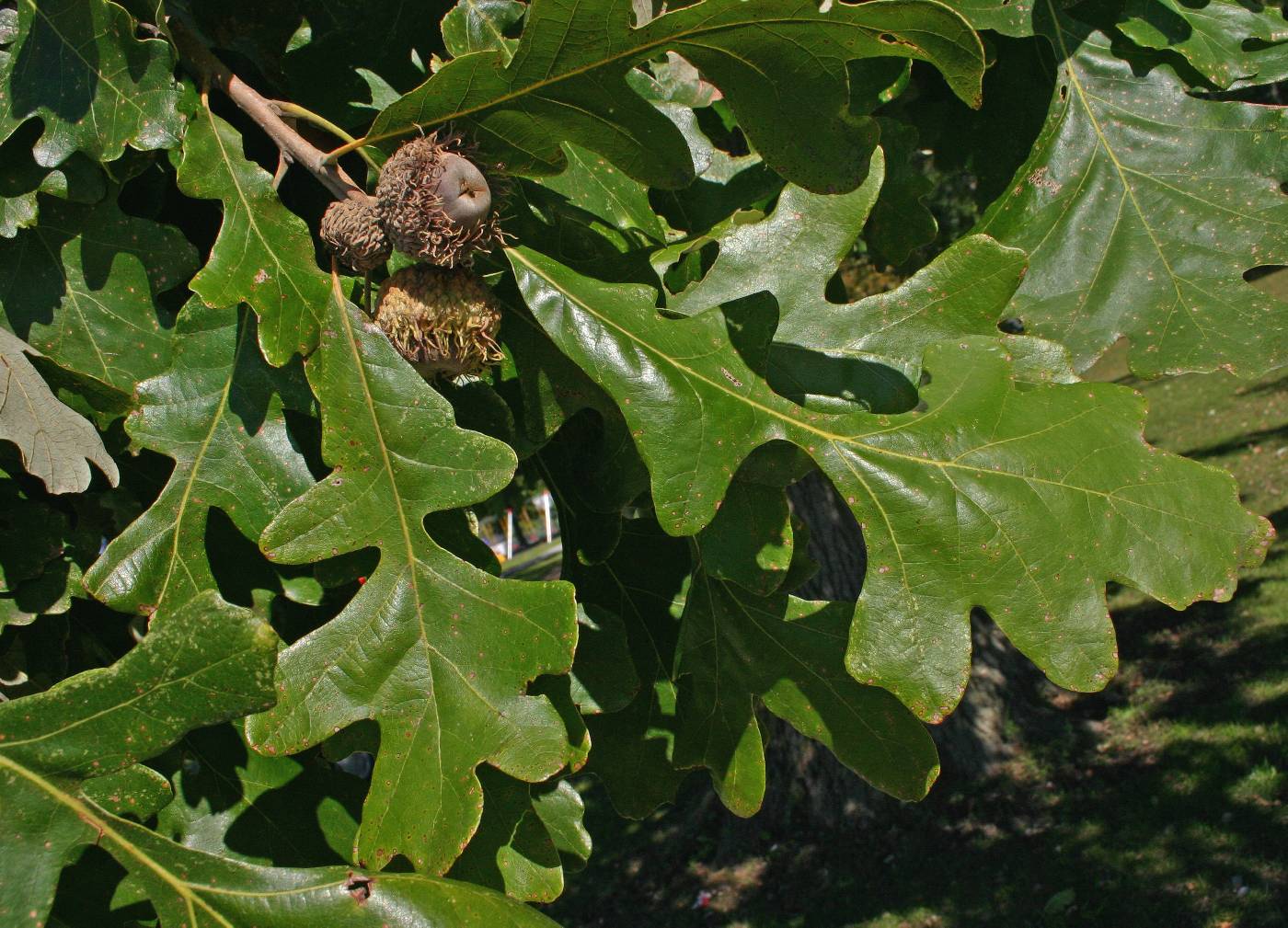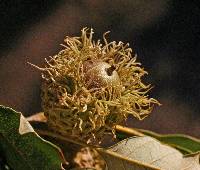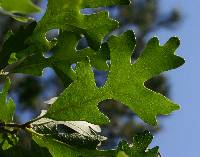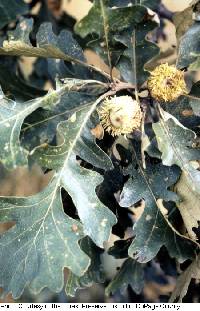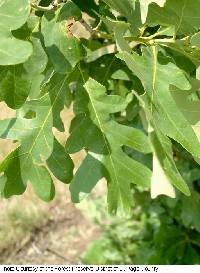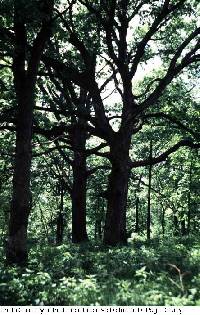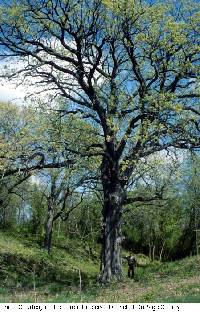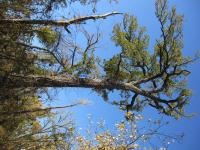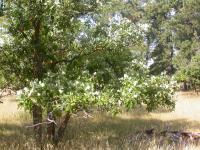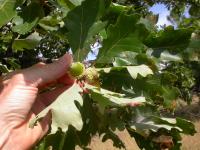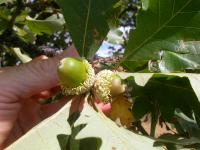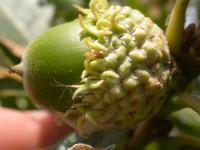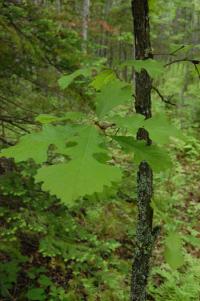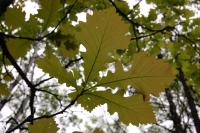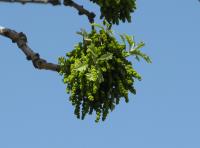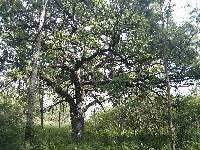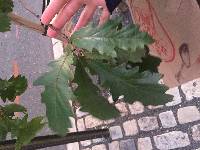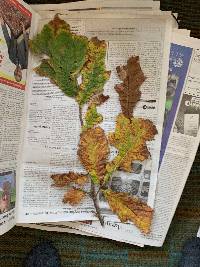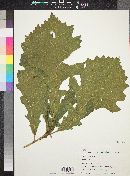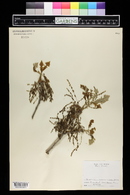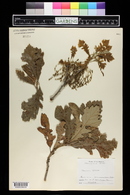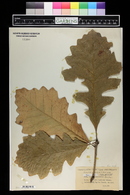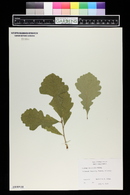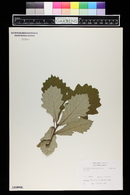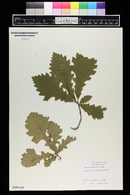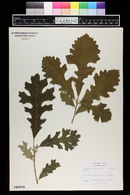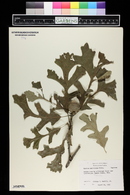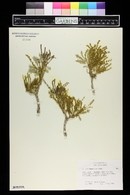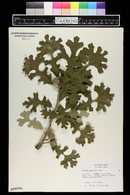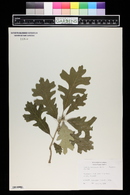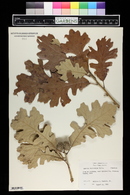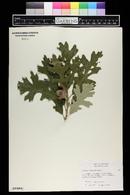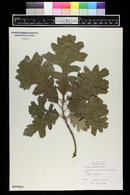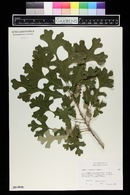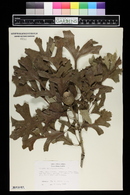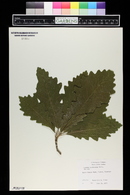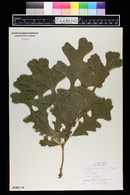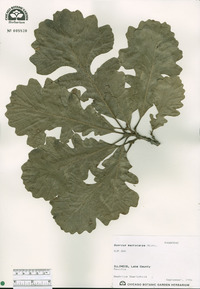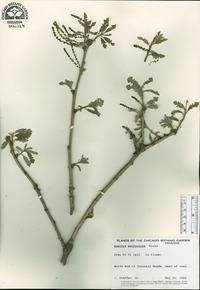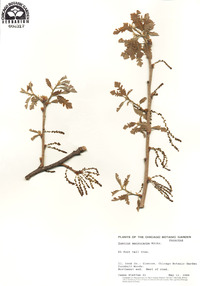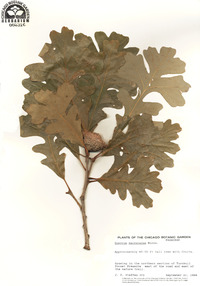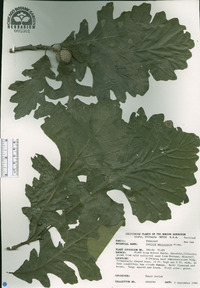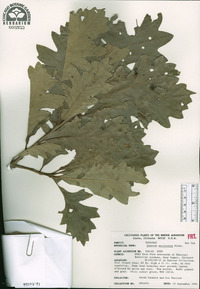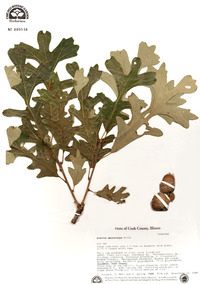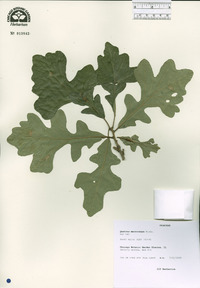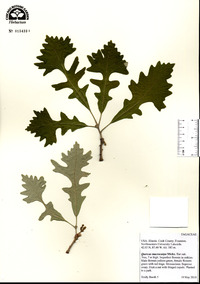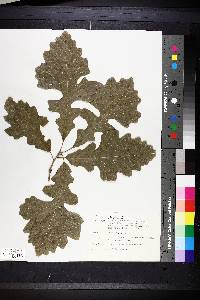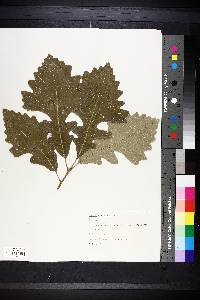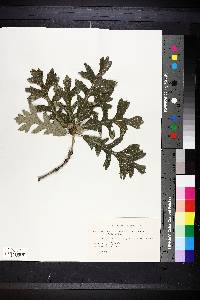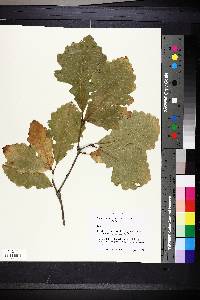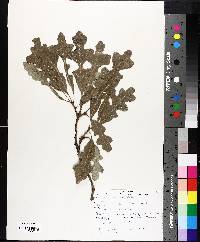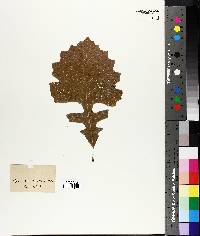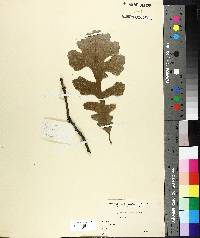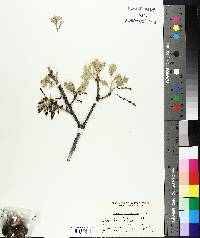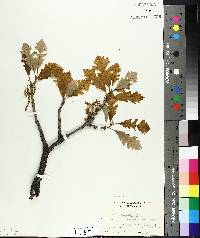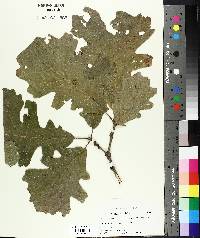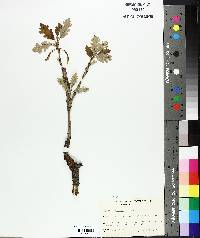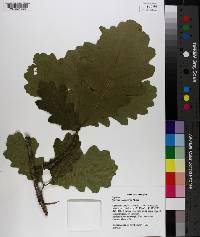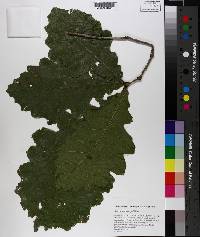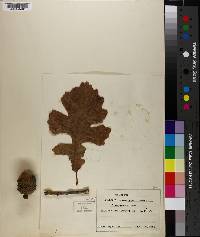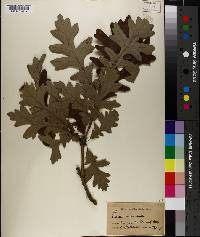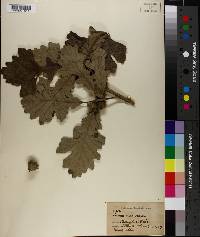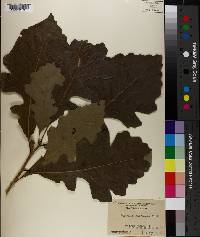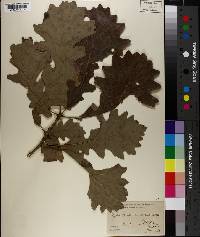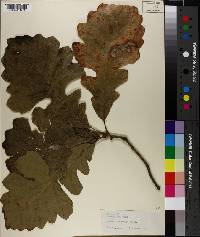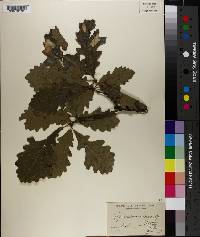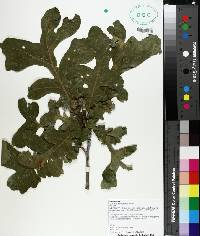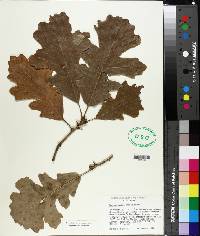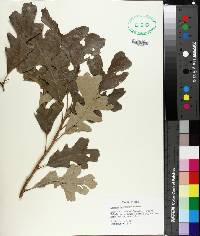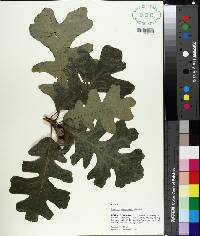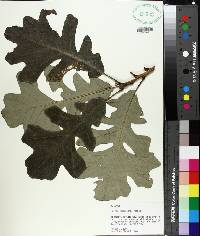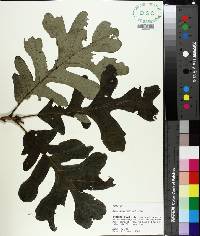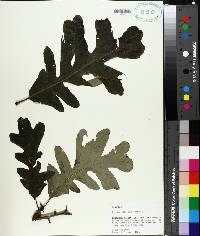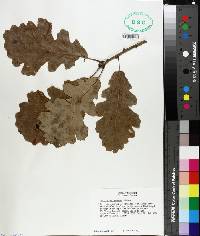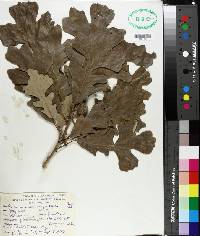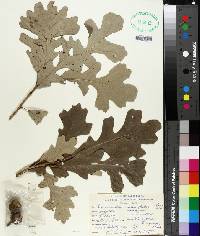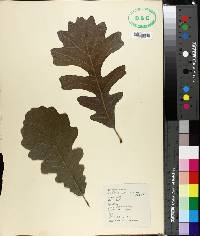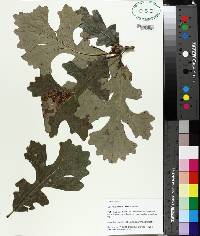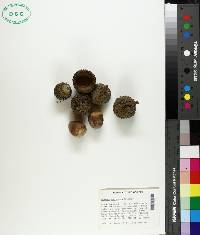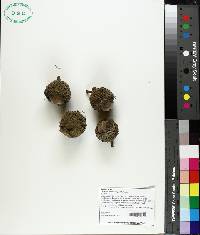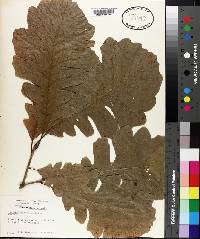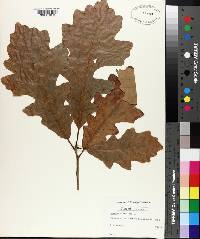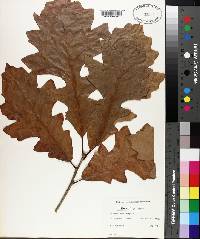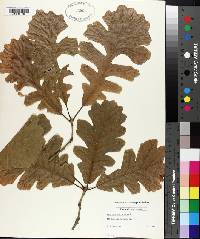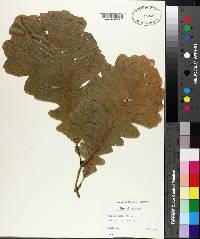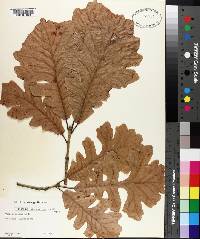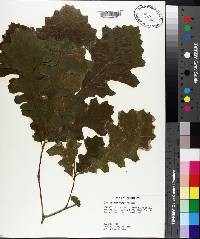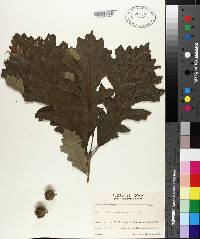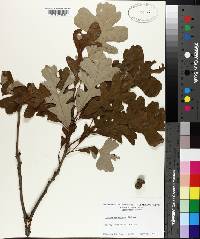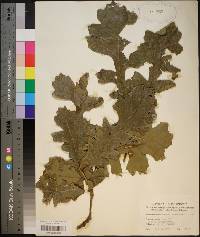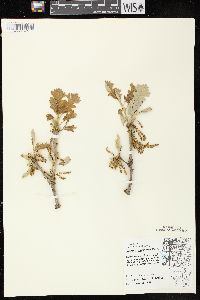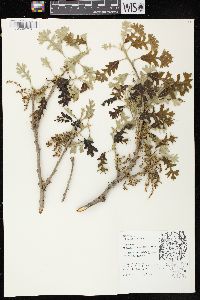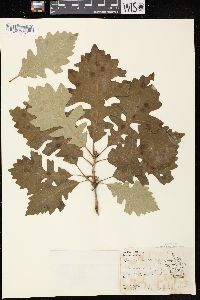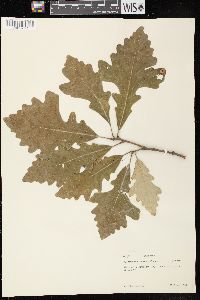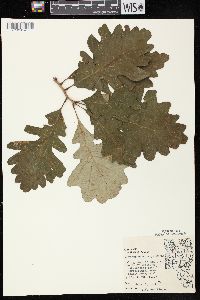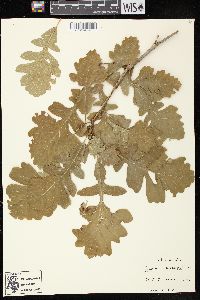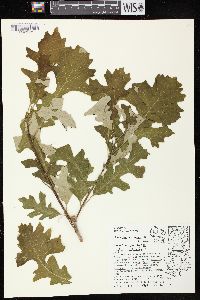
|
|
|
|
Family: Fagaceae
Burr Oak, more...bur oak
|
Trees , deciduous, to 30(-50) m. Bark dark gray, scaly or flat-ridged. Twigs grayish or reddish, 2-4 mm diam., often forming extensive flat, radiating, corky wings, finely pubescent. Buds 2-5(-6) mm, glabrous. Leaves: petiole (6-)15-25(-30) mm. Leaf blade obovate to narrowly elliptic or narrowly obovate, often fiddle-shaped, (50-)70-150(-310) × (40-)50-130(-160) mm, base rounded to cuneate, margins moderately to deeply lobed, toothed, deepest sinuses near midleaf (at least in proximal 2/3), sinuses reaching nearly to midrib, longer lobes grading into shallow lobes or merely simple teeth distally, shallower, compound lobes proximally, secondary veins arched, divergent, 4-5(-10) on each side, apex broadly rounded or ovate; surfaces abaxially light green or whitish, with minute appressed-stellate hairs forming dense, rarely sparse, tomentum, erect felty hairs absent, adaxially dark green or dull gray, sparsely puberulent to glabrate. Acorns 1-3 on stout peduncle (0-)6-20(-25) mm; cup hemispheric or turbinate, (8-)15-50 mm deep × (10-)20-60 mm wide, enclosing 1/2-7/8 nut or more, scales closely appressed, laterally connate, broadly triangular, keeled, tuberculate, finely grayish tomentose, those near margins often with soft awns to 5-10 mm or more, forming fringe around nut; nut light brown or grayish, ovoid-ellipsoid or oblong, (15-)25-50 × (10-)20-40 mm, finely puberulent or floccose. Cotyledons distinct. 2 n = 24. Flowering in spring. Bottomlands, riparian slopes, poorly drained areas, prairies, usually on limestone or calcareous clays (in nw part of range on dry slopes and ridges, prairies); 0-1000 m; Man., N.B., Sask., Ont., Que.; Ala., Ark., Conn., Ill., Ind., Iowa, Kans., Ky., La., Maine, Md., Mass., Mich., Minn., Mo., Mont., Nebr., N.J., N.Y., N.Dak., Ohio, Okla., Pa., S.Dak., Tenn., Tex., Vt., Va., W.Va., Wis., Wyo. Quercus macrocarpa is one of our most cold-tolerant oak species; it also endures a wide variety of other harsh conditions including poor dry soils and wet, poorly drained, and inundated locations. Putative hybrids with Q . bicolor are common in the northeastern part of its range, where the two species often occur together in wet, poorly drained habitats. The effect of this contact may be partially responsible for morphologic differences across the range of Q . macrocarpa . The large acorns are best developed in the southern part of the range, and a clinal decrease in acorn size and extent of the mossy fringe on the acorn cup seems to occur as one travels from south to north. In the northwest part of its range, Q . macrocarpa varies clinally to smaller, shrubbier forms on bluffs and hillsides, with smaller, less fringed cups, that are the basis of Q . macrocarpa var. depressa (Nuttall) Engelmann and Q . mandanensis Rydberg. These scrubby forms may merit formal recognition after more thorough study; they are treated here as clinal variants of the species. Quercus macrocarpa forms putative hybrids also with Q . alba in the savannah-type regions of the midwest. Putative hybrids with Q . gambelii occur out of the range of Q . macrocarpa . Quercus macrocarpa is the only oak species native to Montana (in the southeast corner). Wood of Q . macrocarpa is similar to that of Q . alba and produces one of the best and most durable oak lumbers. Native Americans used Quercus macrocarpa medicinally to treat heart troubles, cramps, diarrhea, Italian itch, and broken bones, to expel pinworms, and as an astringent (D. E. Moerman 1986).
Tree to 37 m tall, trunk to 1.5 m in diameter Leaves: alternate, short-stalked, dark green above, pale and hairy beneath, to 35.5 cm long and 18 cm wide, inversely egg-shaped, with five to seven deep and rounded lobes. Leaves turn yellowish brown in fall. Flowers: either male or female, found on the same tree (monoecious), yellow male flowers borne in hanging catkins 10 - 15 cm long, reddish female flowers borne near leaf axils. Fruit: an acorn, maturing in one season, usually solitary. The stalkless or short-stalked and hairy cup covers one-third or more of the nut and has a distinctly long-fringed margin. Nut dark brown and 1.5 - 3 cm long. Bark: dark brown or yellowish brown, becoming deeply furrowed. Twigs: stout, dark brown, often with corky ridges. Buds: yellowish to reddish brown, rounded or slightly pointed at the tip. Each terminal bud is surrounded by a cluster of lateral buds. Form: broad and rounded with large, sometimes gnarled branches. Similar species: Many oaks in the white oak group and Quercus robur have highly variable, similar leaves with rounded lobes. Quercus alba often has deeply lobed leaves, light gray bark usually with smooth patches, and an acorn cup covered with warty scales. Quercus bicolor has round-toothed to shallowly lobed leaves that are whitish and hairy beneath, peeling bark on young branches, and a long-stalked acorn cup. Quercus lyrata has leaves that are inversely egg-shaped with irregular, rounded lobes, and an acorn cup that nearly covers the nut. Quercus robur has very short-stalked leaves with ear-like lobes at the base, and a long-stalked acorn cup. Flowering: mid April to early June Habitat and ecology: Very common in open woodlands, also dry hillsides to moist bottomlands, mainly in limestone soils. Occurence in the Chicago region: native Notes: This drought- and fire-resistant, hardy oak once grew in presettlement prairies. It continues to be an important food source for many wild animals. Quercus macrocarpa naturally hybridizes with Q. alba (Q. x bebbiana). Etymology: Quercus is the Latin name for oak. Macrocarpa means "large fruit." Author: The Morton Arboretum Low shrub to tall tree, the latter with rough, deeply furrowed bark; lvs large, oblong to obovate, cuneate at base, pale beneath with a close, fine stellate pubescence, with 4-7 pairs of blunt or acute lateral lobes, a pair of sinuses near the middle usually deeper than the others; winter- buds pubescent; fr sessile or stoutly short-peduncled, the cup covering a third to more often two-thirds or even all the nut, pubescent within, the marginal scales acuminate into slender awns forming a terminal fringe; nut depressed-ovoid to narrowly ovoid, 1-4 cm thick. Var. macrocarpa, a tree to 50 m, occurs in moist woods and alluvial flood-plains from N.B. and Que. to Ont. and s. Man., s. to Va., La., and Tex. Var. depressa (Nutt.) Engelm. (Q. mandanensis), a shrub to 5 m, with acorns of minimal size that have a relatively short marginal fringe, occurs on dry uplands and bluffs from w. Minn. and Io. to Sask., Mont., and Wyo. Gleason, Henry A. & Cronquist, Arthur J. 1991. Manual of vascular plants of northeastern United States and adjacent Canada. lxxv + 910 pp. ©The New York Botanical Garden. All rights reserved. Used by permission. From Flora of Indiana (1940) by Charles C. Deam Doubtless occurring in every county of the state, although it may be very rare in some of the hilly counties of the unglaciated area. This species is generally found in wet places in woods and along streams. It is a pioneer tree in the prairie counties where it grows both in low ground and on high ground and even on sandy ridges. In the prairie area it sometimes forms pure stands. I have noted it as a common tree in areas that undoubtedly were formerly prairies in Kosciusko, Lagrange, Noble, and Steuben Counties. [Variety olivaeformis] is distinguished from the typical form by its shallow cup and the long, oval nut which is often 3 cm long. The cup is semi-hemispheric and encloses the nut for about half its length. It is rare. I have specimens from Wells County, and it has been reported from Gibson and Hamilton Counties. [According to Deam Quercus × hillii Trel] is believed to be a hybrid between Quercus macrocarpa and Q. muehlenbergii. A single tree was found by Hill near Roby, Indiana. I report this on the authority of Sargent. I have a duplicate specimen but I believe it is only a specimen of the bur oak. I question the determination of this specimen because the last named parent of the hybrid does not occur there or, if it does, it is extremely rare. …… Indiana Coefficient of Conservatism: C = 5 Wetland Indicator Status: FAC Deam (1932): Wood and uses similar to those of white oak. In point of number, size, and value it ranks as one of the most valuable trees of the state. Michaux says (in North American Silva. J.J. Smith's Trans. 1:37. 1871): "A tree three miles from Troy, Ohio, was measured that was fourteen feet and nine inches in diameter six feet above the ground. The trunk rises about fifty feet without limbs, and with scarcely a perceptible diminution in size." In Kosciusko County about four miles northwest of Warsaw on the farm of Hiram A. and Martin L. Berkey, there stands a tree of this species that is the largest in Indiana and no doubt the largest of its kind in the United States. It is visited annually by thousands of people from many states. The owners of this tree are to be congratulated that no admission charge or restrictins are made for seeing this wonder of the tree world. State Forester Ralph F. Wilcox and I measured this tree in 1926 and it was 7 feet 1 inch in diameter at 4 1/2 feet above the ground. |
|
|
|

